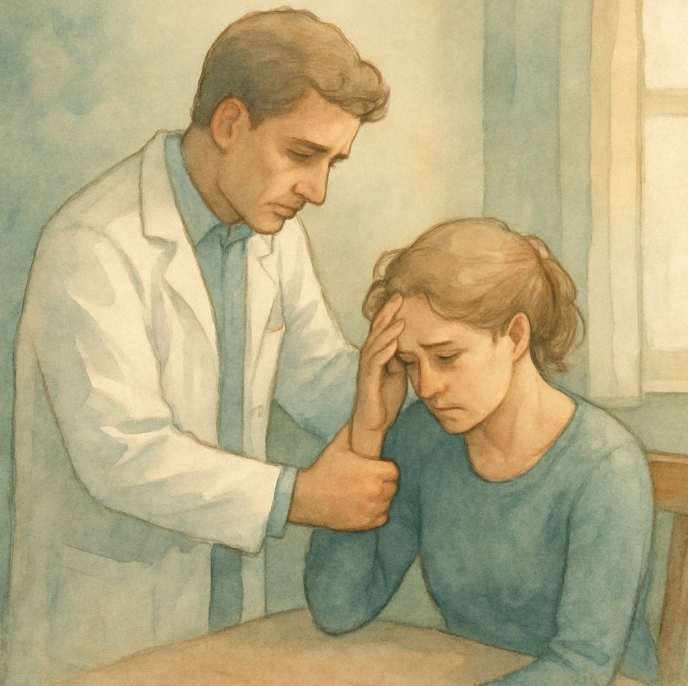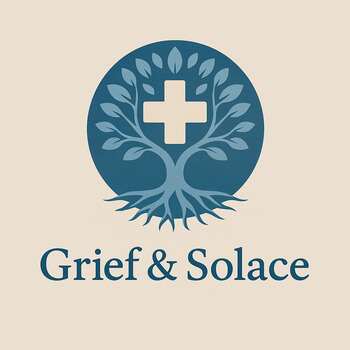Grieving Functional Neurological Disorder: When the Body and Mind Betray Together
Grief tied to functional neurological disorder blurs the line between mind and muscle, mourning what you can’t fix and what doctors can’t always see.

This post blends real grief with grounded knowledge. It isn’t clinical. It isn’t distant. It’s meant to sit beside you—not above you. The story you’ll read is meant to reflect what so many feel when living through or witnessing this condition: confusion, exhaustion, and quiet forms of courage.
If what you read feels familiar, please speak with your doctor. Your pain deserves more than silence.
They Said It Was All in Her Head, but I Saw It in Her Eyes
She didn’t fall for any drama. No collapse, no fit, no cinematic moment. Just… froze. Like a marionette with its strings cut. Her fork hovered in mid-air, her gaze locked onto the fridge. And then, as if the world had vacated her body, she was lost.
The first time it happened, I feared it was a stroke. The second time? I thought it was a panic attack. By the fifth time? I found myself hoping it was something medical. Because at least then we’d have a name, a pill, a path forward.
But no. The scans returned clean. The bloodwork was normal. “Her body isn’t broken,” they said.
🧠 Symptoms:
- Motor symptoms: Weakness or paralysis, abnormal movements (e.g., tremors, dystonic movements), gait abnormalities, difficulty swallowing, and non-epileptic seizures.
- Sensory symptoms: Numbness or loss of touch sensation, vision problems (e.g., double vision or blindness), hearing issues, and speech difficulties (e.g., slurred speech or inability to speak).
- Cognitive symptoms: Memory and concentration difficulties.
- Symptoms can vary widely and may affect body movement, function, and the senses. -Mayo Clinic
So, they began to look at her—not her brain, not her nerves, but her.
They told her it was stress. That maybe she just needed to rest. That perhaps she was too sensitive. That maybe…just maybe…it wasn’t real.
I watched her sit through those appointments, hands in her lap, fingers twitching as if trying to apologize for existing. She didn’t argue. She didn’t cry. Just nodded while the floor tilted beneath her.
I don’t care what the chart says. I’ve witnessed her body betray her. I’ve seen her legs stop responding mid-step. I’ve heard her voice stutter like a scratched record. I’ve seen her forget how to swallow for three minutes straight while the ER nurse assured me, “She seems fine now.”
It’s not imagined. It’s not for attention. It’s not hysteria or masked anxiety, or some polite version of madness.
It’s real. It’s every day. It’s stealing pieces of her while no one acknowledges it.
Complications:
- Disability: Symptoms can lead to substantial disability and poor quality of life.
- Associated conditions: Pain, anxiety disorders (including panic disorder), depression, insomnia, and fatigue.
Risk Factors:
- Neurological diseases: Such as epilepsy, migraines, or movement disorders.
- Recent significant stress or trauma: Emotional or physical.
- Mental health conditions: Mood or anxiety disorders, dissociative disorders, or certain personality disorders.
- Family history: Having a family member with a neurological condition or symptoms.
- History of abuse or neglect: Physical or sexual abuse or neglect in childhood.
- Gender: Females may be more likely than males to develop the disorder.
Causes:
- Unknown exact cause: The condition may be triggered by a neurological disorder or by a reaction to stress or psychological or physical trauma.
- Brain function alterations: Involvement of brain areas controlling muscles and senses, even without structural abnormalities.
- Stressful events: Symptoms may appear suddenly after stressful events or emotional/physical trauma.
Eventually, they labeled it Functional Neurologic Disorder, a term that sounds clinical, neutral, and safe. But it doesn’t feel safe. It feels like waiting for gravity to shift once more.
She’s learned to walk slowly now. Carries a cane on some days. Uses a whiteboard for the words that fail her when she needs them most. And she’s only thirty-seven.
Some mornings, I help her get dressed…not because she can’t, but because she doesn’t trust her body to remember how. That’s the hardest part, I think. The way she doubts herself now. The way those doctors made her question her own reality.
Because when they said, “It’s all in your head”, they meant it wasn’t real.
But I saw it. I see it every single day. In her tremors. In her flinches. In the way, she clings to the railing even when she doesn’t need to.
And in her eyes. Always her eyes. Those are the only part of her that hasn’t forgotten who she is.
She stopped believing her own pain because no one else would name it—but I did. I called it real.
📘 Diagnosis & Treatment
Diagnosis:
- Clinical assessment: Based on specific patterns of signs and symptoms.
- Exclusion of other conditions: Ruling out neurological or other medical conditions.
- Multidisciplinary evaluation: Involves neurologists, psychiatrists, and other specialists.
- DSM-5 criteria: Comparison of symptoms to diagnostic criteria for functional neurological symptom disorder.
Treatment:
- Education: Understanding that symptoms are real and improvement is possible.
Therapies:
- Physical or occupational therapy: Improves movement symptoms and prevents complications.
- Speech therapy: Assists with speech or swallowing difficulties.
- Stress reduction techniques: Progressive muscle relaxation, breathing exercises, and physical activity.
Mental health options:
- Cognitive behavioral therapy (CBT): Helps manage symptoms and stress.
- Treatment of coexisting mental health conditions: Addressing anxiety, depression, or other disorders.
- Medications: Not specifically approved for the disorder, but antidepressants may help if mood disorders are present.
- Regular follow-up: Monitoring recovery and adjusting treatment plans as needed.
I know this is heavy, and I understand that the road ahead may feel like a tangle of loss and unanswered questions. But please hear this: you are not broken because you are hurting; you are not weak because you are afraid. You are living through something real, and survival itself is a kind of grace. You are allowed to struggle, you are allowed to hope, and you are allowed to not have all the answers today. Whatever comes next, you do not face it empty-handed; you carry every moment of love that shaped you, and that will always be enough to keep going.
🎀 Gifts to help With Functional Neurological Disorder
🏥 Everyday Comforts for Everyday Battles
Managing Functional Neurological Disorder often means needing a little extra help.
Sometimes it’s about restoring dignity, ease, or simply getting through the day with less pain.
These carefully chosen tools aren’t just items; they’re small bridges back to living.
This section is about finding practical support, never shame.
Adaptive Grabber Tool – Control When the Body Won’t Cooperate
FND can affect mobility, coordination, and strength in unpredictable ways. This adaptive grabber helps reclaim small moments of independence—reaching dropped items, handling chores, and navigating life when your limbs go offline. It’s not flashy. But when your body betrays you, even picking something up can feel like a win.
🌿 Paths to Healing Beyond the Map
Sometimes traditional medicine isn’t enough.
If you’re exploring gentle, alternative options to help with Functional Neurological Disorder,
you might find comfort in plant-based compounds like **CBD or CBG**.
*This section is not medical advice, just a door left open.*
USA Medical Stress Relief Total Pack – Soothing the Nervous System’s False Alarms
FND isn’t imagined—it’s misfiring. The nervous system sends the wrong signals, triggered by stress, trauma, or exhaustion. This Total Pack blends CBD, calming botanicals, and emotional resilience support to help ease the neurological overload. It won’t undo the glitch. But it may help soften the noise and stabilize the threshold.
Need a Different Path Forward?
Every journey through grief looks different. Choose the next step that speaks to where you are now:
When You're Ready to Start Healing
Healing doesn’t mean forgetting.
It means finding small ways to carry your grief with strength and grace.
These are the stories, tools, and gentle steps to begin walking forward…at your own pace.
When You're Still in the Thick of It
Sometimes healing feels like a lie.
If you’re not ready to move on…if the pain still roars louder than the world wants to hear…this is the place where you’re allowed to feel it.
No sugarcoating. No pretending. Just truth.
When You're Holding on to Who’s Still Here
Grief reminds us to love louder.
If someone you love is still with you, this is your place to celebrate them, honor them, and create new memories while there’s still time.
Joy and sorrow can live side by side.






